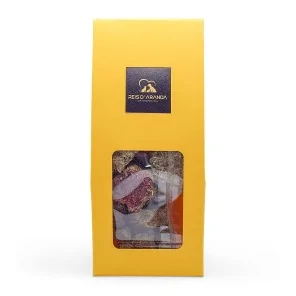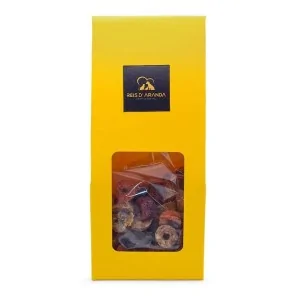Its name says it all: the Vienna blue rabbit comes from Austria. Not only is it beautiful with its shiny blue-grey...
THE MINI CASHMERE LOP RABBIT
INTRODUCTION
The Cashmere Lop is a more recent breed that was discovered inside the Dwarf Lop rabbit nest by Miss Turner from Wales in 1980. She noticed that there was something different about some of the rabbits in the nest, as some had a thicker, longer and more luxurious coat than the rest.
THE ORIGIN OF THE MINI CASHMERE LOP
The Cashmere Lop is a more recent breed that was discovered inside the Dwarf Lop rabbit nest by Miss Turner from Wales in 1980. She noticed that there was something different about some of the rabbits in the nest, as some had thicker, longer and more luxurious fur than the rest.
Six years later, the Cashmere Lop began to gain popularity. In the mid-1990s, the breed began to appear at shows, gaining a wider audience, and breeders began to work on developing the breed so that it could be standardised.
When the National Cashmere Lop Club was founded, the breed was recognised in all colours, and the breed continues to be popular and is found in shows all over the world. The miniature cashmere was first seen about a decade later and the breed was finally standardised in all colours.
The standard Cashmere Lop and the Cashmere Mini are recognised by the British Rabbit Council (BRC), but not by the American Rabbit Breeders Association (ARBA), the latter have an extremely similar breed called ‘Fuzzy Lop’.
In Spain the Cashmere Lop is recognised by AECCE and ASNAC.
THE STANDARD OF THE MINI CASHMERE LOP
1. TYPE: The type should be strong, compact and firm. The body should be short, broad and muscular, with little visibility of the neck. The hindquarters should be short and well rounded, with a broad and deep chest. The general appearance shows a compact impression. The front legs are thick, short and straight. The hind legs are short, strong, powerful and should be parallel to the body. The tail is strong, straight and well docked.
2. HEAD, EARS AND CROWN: The head should have strong, bold, broad cheeks, well developed in conjunction with the shoulders.
The ears are broad, thick and hairy, with rounded tips. They meet at the cheeks, like a horseshoe when viewed from the front. The inside of the ears should not be visible from any angle.
The crown, which is the basal ridge of each ear should be deployed at the top of the skull.
The eyes should be bold and bright.
COAT: The coat is dense, the top coat should be longer and heavier than the undercoat with longer hairs and a strong undercoat. The size of the coat should be approximately 3.81 cm to 5.08 cm and should not be woolly, matted felt or dull. The coat falls naturally downwards. Regularity is more important than length.
4. COLOUR: Shall conform to the recognised colour pattern for Cashmere, which are as follows:
- SOLIDS: REW, BEW, Black, Blue, Chocolate and Lilac.
- AGOUTIES: Agouti, Opal, Cinnamon, Linx, Chinchilla and Squirrel
- SHADOWS: Siames Sable, Siames Smoke Pearl, Seal Point, Blue Point, Sooty Fawn, Beige, Iron Grey, Chocolate Tort
- TAN: Fox and Otter (Black, blue, chocolates and lilacs), Siames Marten Sable and Siames Marten Smoke
- OTHERS: Orange, Fawn, Butterfly and Steel. Plus any other recognised colour pattern for other breeds, excluding Broken.
5. WEIGHT: 1.600 gr maximum.
6. DEFECTS: White hair on solid colours. White nails on coloured specimens for show. Coat too soft or too stiff.
7. DISQUALIFICATIONS: Overweight, coat irregularities, malocclusion and any deformity.
THE HEALTH OF THE MINI CASHMERE LOP
The Cashmere Lop is a generally hardy breed, cases of otitis are not common. Like other breeds and crossbreeds, this rabbit's teeth will grow continuously, so food such as fibrous green vegetables and hay should be provided to wear down the teeth and prevent overgrowth; if not fed well it is very likely to develop intestinal problems and dental overgrowth.
Animals from a skilled and ethical breeder are very unlikely to have genetic malocclusion.
Another common problem is flystrike (myiasis), more likely if your rabbit is overweight and unable to groom. You also need to vaccinate your pet against viral haemorrhagic disease and myxomatosis, and treat your rabbit for ticks, fleas and worms whenever necessary.
As far as the Cashmere's coat is concerned, it is very easy to care for as it is thick and of medium length, so it will be fine if brushed from root to tip twice a week with a medium length carder. it is not necessary to apply a dry moisturiser to this type of coat.
THE MINI CASHMERE LOP AS A PET
Cashmere Lop and Mini Cashmere Lop make excellent pets as they get on well with adults and older children. These animals are friendly, bright and intelligent. They will greet humans they learn to recognise and can even learn their names. Many also like to be petted and held. In addition, you can train your pet to use the litter tray. In general, you can expect these rabbits to be friendly and playful.
CONCLUSION
These rabbits are popular for their looks but also for their outstanding personality. They are not very big, but their fur makes up for it because they can measure a few centimetres and come in various colours.
In Spain there are no official or federated breeders of Cashmere Lop, but there have been some cases of Cashmere genes in litters of Mini Lop in the past.
Leave a comment
Log in to post comments
















